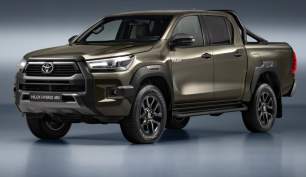Ute ranges being the insanely complex webs they are, you’ll be unsurprised to hear there are lots of options here. In fact, there are some 25 combinations, spanning six grades, two engines, two gearboxes, a choice of two- or four-wheel drive and four body styles.
The price range is vast, too, now starting at $32,700 for the SX Single Cab Chassis with a 1.9-litre turbo-diesel and two-wheel drive, and climbing to a $70,500 MSRP for the X-Terrain Crew Cab with a 3.0-litre turbo-diesel and four-wheel drive.
To keep this brief, we'll focus on the Crew Cab Ute, which is yours in SX, LS-U, LS-U+, LS-M, X-Rider and X-Terrain guises, but we will also post a full price list below so you can choose your own adventure.
The SX range is now $500 more expensive across the board, and it starts at $42,700 with a 1.9-litre engine and two-wheel drive, or $50,700 for four-wheel drive. If you want the bigger 3.0-litre powerplant, it’s $44,700 for the 2WD, or $52,700 for the 4x4.
Then it’s the LS-U, which is big-engine only, and is $54.5k (which is up by $1500, by the way) for the 4x2, and $62.5k (again up $1.5k) for the 4x4. There’s also a LS-U+, which is $65,500 in 4x4.
Next is the LS-M, which is $55,800 (up $500), before the new-for-2024 X-Rider jumps in at $59,500. Both are four-wheel drive only and feature only the big engine.
Finally, there’s the flagship X-Terrain — big engine only, and four-wheel drive as standard — which is $70,500 (up a sizeable $3k), but which is also just $67,990 drive-away, at least for now.
The entry-level SX gets a vinyl floor, cloth seats, powered windows and mirrors, and air-conditioning with rear vents. Tech is handled by a new 8.0-inch central touchscreen with wireless Apple CarPlay and Android Auto, pairing with four speakers, while an also-new 4.2-inch screen sits in the driver’s binnacle. You also get 17-inch steel wheels, automatic wipers and halogen headlights.
Stepping up to LS-M trim gets you new and softer rear suspension, a higher-grade cloth interior treatment, bi-LED headlights and DRLs, 17-inch alloy wheels and body-coloured mirrors, door handles and tailgate handle. If you can spring for this trim, it feels like the sweet spot of the lower-range models.
Next there’s the new X-Rider, which was once was a special edition but now rejoins as a permanent member of the family. It’s all about upping the street credibility, so there’s black gloss on the grille and a black underbody spoiler, as well as black on the rear step bar, the mirrors, door handles and tailgate handle, the B-pillars, the sports bar and on the soft tonneau cover. There are also black 17-inch alloy wheels and dark grey side steps.
Next up is the LS-U, which ups the cabin tech with a new 9.0-inch central screen, but with tactile dials for volume — fixing what was apparently a big complaint about the outgoing D-Max – as well as a new 7.0-inch Driver Display. There’s also keyless entry and push-button start, including a new welcome light that illuminates the interior when you approach, dual-zone climate control and a nicer interior treatment. Outside, there’s a tub liner, silver side steps, chrome on the handles and mirrors and 18-inch alloys.
The LS-U+ then adds leather seats which are heated in the front and eight-way power-adjustable for the driver, and four-way power-adjustable for the front passenger.
Finally, the flagship X-Terrain gets red stitching across its leather interior, remote engine start, a rolling tonneau cover, a unique sport bar, dark grey side steps, mirrors, handles and roof rails, and 18-inch matte-grey alloys wheels.
2024 Isuzu D-MAX Pricing (RRP before on-road costs unless specified)



































